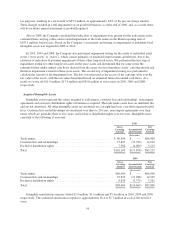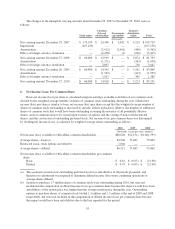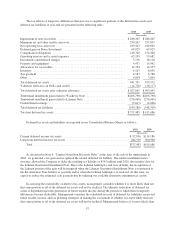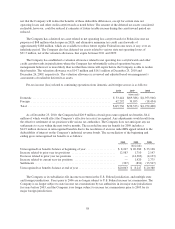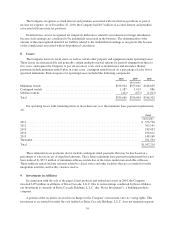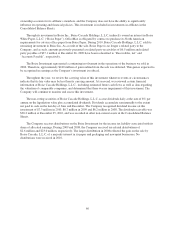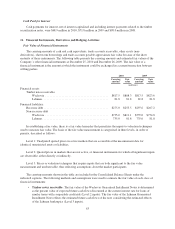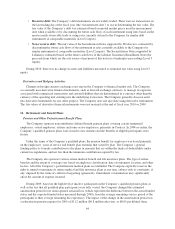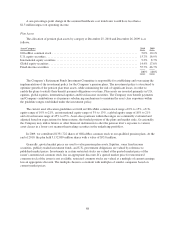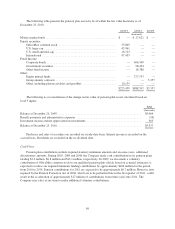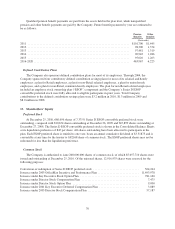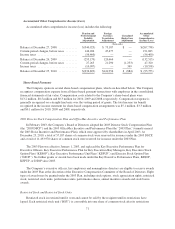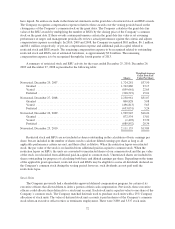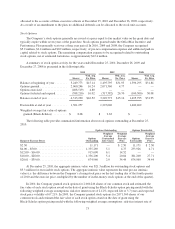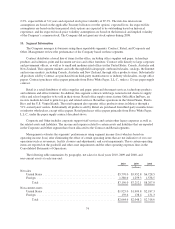OfficeMax 2010 Annual Report Download - page 84
Download and view the complete annual report
Please find page 84 of the 2010 OfficeMax annual report below. You can navigate through the pages in the report by either clicking on the pages listed below, or by using the keyword search tool below to find specific information within the annual report.•Recourse debt: The Company’s debt instruments are not widely traded. There were no transactions on
the last trading day of the fiscal year (the “measurement date”) to use in determining the fair value. The
fair value of the Company’s debt was estimated based on quoted market prices near the measurement
date when available or by discounting the future cash flows of each instrument using rates based on the
most recently observable trade or using rates currently offered to the Company for similar debt
instruments of comparable maturities (Level 2 inputs).
•Non-recourse debt: The fair value of the Securitization Notes supported by Wachovia is estimated by
discounting the future cash flows of the instrument at rates currently available to the Company for
similar instruments of comparable maturities (Level 2 inputs). The Securitization Notes supported by
Lehman is estimated based on the future cash flows of the Lehman Guaranteed Installment Note (the
proceeds from which are the sole source of payment of this note) in a bankruptcy proceeding (Level 3
inputs).
During 2010, there was no change in assets and liabilities measured at estimated fair value using Level 3
inputs.
Derivatives and Hedging Activities
Changes in foreign currency exchange rates expose the Company to financial market risk. The Company
occasionally uses derivative financial instruments, such as forward exchange contracts, to manage its exposure
associated with commercial transactions and certain liabilities that are denominated in a currency other than the
currency of the operating unit entering into the underlying transaction. The Company generally does not enter
into derivative instruments for any other purpose. The Company does not speculate using derivative instruments.
The fair values of derivative financial instruments were not material at the end of fiscal year 2010 or 2009.
12. Retirement and Benefit Plans
Pension and Other Postretirement Benefit Plans
The Company sponsors noncontributory defined benefit pension plans covering certain terminated
employees, vested employees, retirees and some active employees, primarily in Contract. In 2004 or earlier, the
Company’s qualified pension plans were closed to new entrants and the benefits of eligible participants were
frozen.
Under the terms of the Company’s qualified plans, the pension benefit for employees was based primarily
on the employees’ years of service and benefit plan formulas that varied by plan. The Company’s general
funding policy is to make contributions to the plans in amounts that are within the limits of deductibility under
current tax regulations, and not less than the minimum contribution required by law.
The Company also sponsors various retiree medical benefit and life insurance plans. The type of retiree
benefits and the extent of coverage vary based on employee classification, date of retirement, location, and other
factors. All of the Company’s postretirement medical plans are unfunded. The Company explicitly reserves the
right to amend or terminate its retiree medical and life insurance plans at any time, subject only to constraints, if
any, imposed by the terms of collective bargaining agreements. Amendment or termination may significantly
affect the amount of expense incurred.
During 2009, based on the high level of inactive participants in the Company’s qualified pension plans as
well as the fact that all qualified plan participants were fully vested, the Company changed the estimated
amortization period for its unrecognized actuarial loss (which represents the difference between the actual funded
status and the expected funded status measured through 2009), from the average remaining service period of the
participants to their average remaining life expectancy. The impact of the change in the amortization period was
a reduction in pension expense for 2009 of $11.2 million ($6.8 million after-tax), or $0.09 per diluted share.
64


